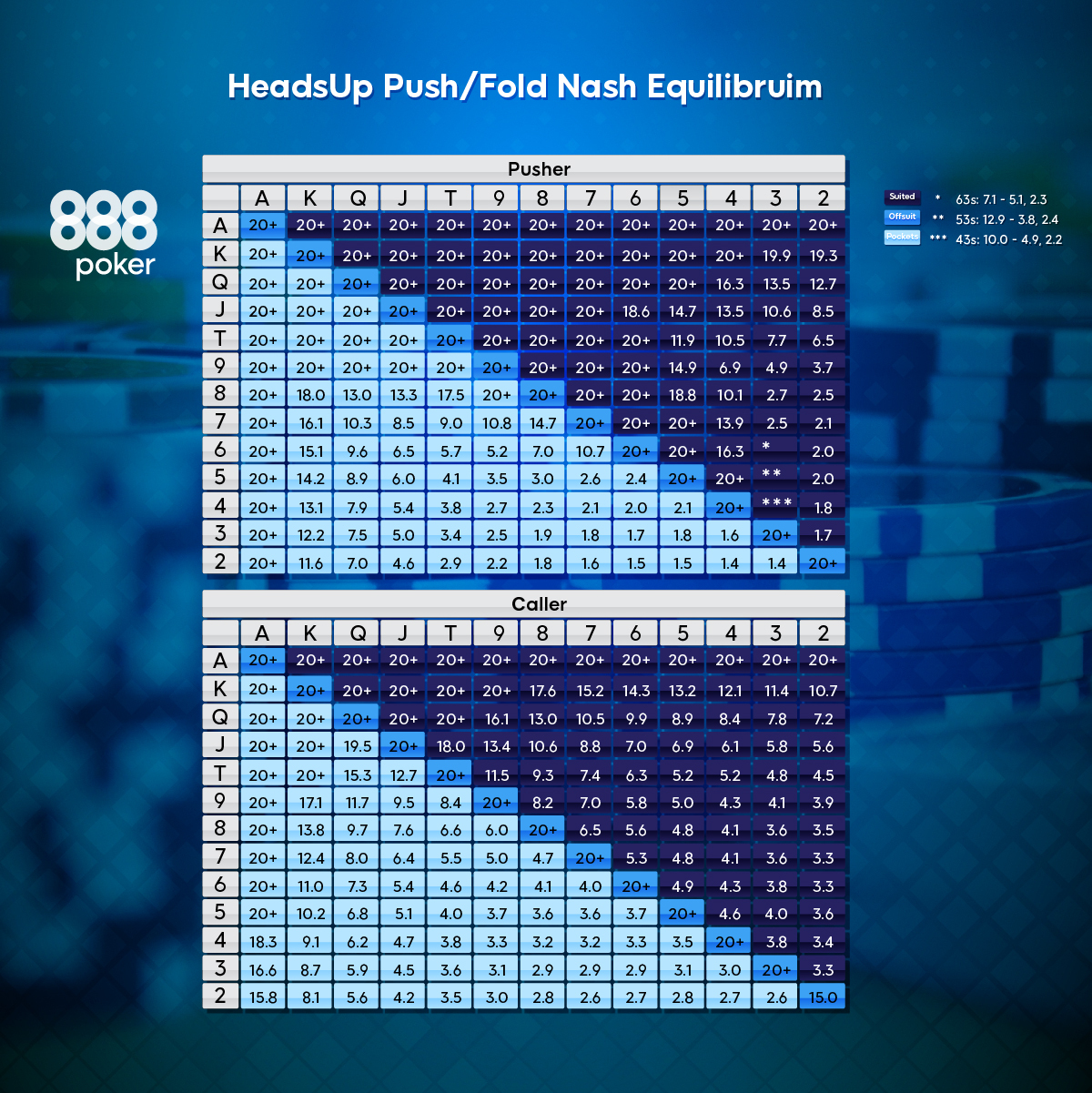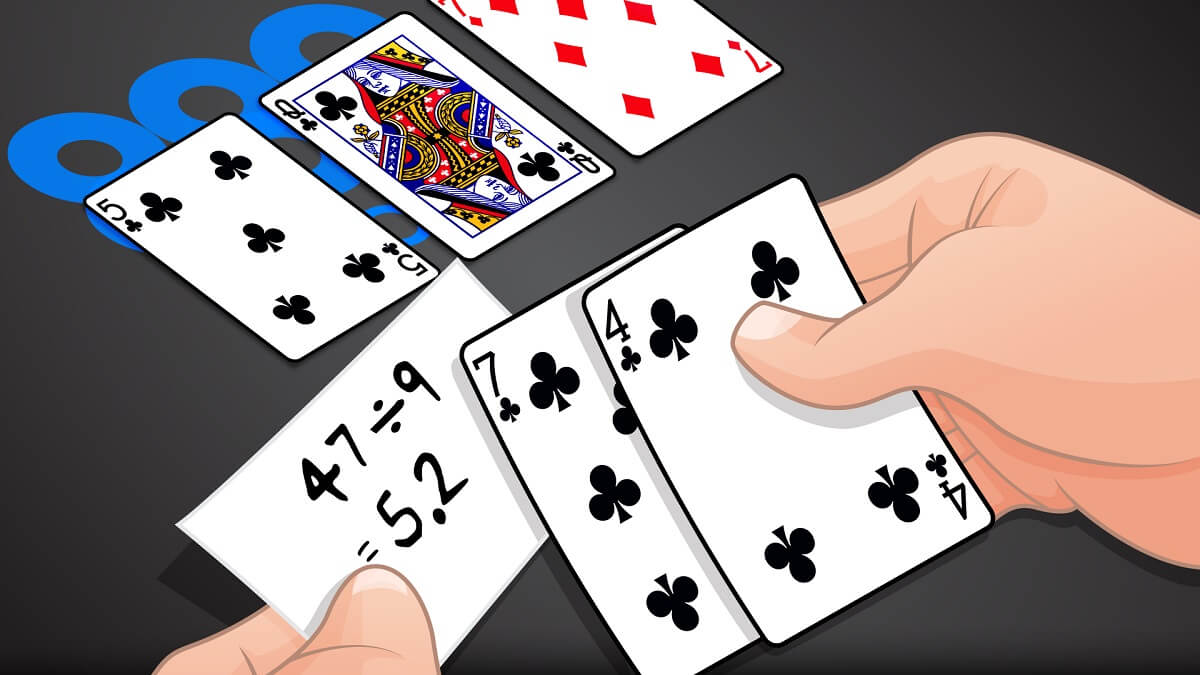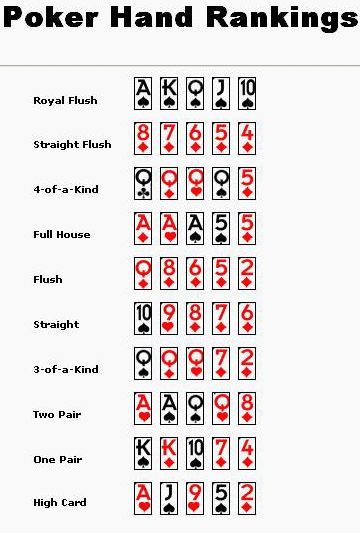Poker Hands Probability Explained
What is the probability that a five-card poker hand has four ACES? When I was solving the above stated problem, I got confused while trying different methods: Assume a normal $52$ deck of cards.
Each poker hand consists of dealing 5 random cards. While the results on the main Poker Probabilities page can be calculated via direct combinatorics, the introduction of wild cards greatly complicates the combinatoric calculations. There are 2,598,960 many possible 5-card Poker hands. Thus the probability of obtaining any one specific hand is 1 in 2,598,960 (roughly 1 in 2.6 million). The probability of obtaining a given type of hands (e.g. Three of a kind) is the number of possible hands for that type over 2,598,960. Thus this is primarily a counting exercise. Poker hands from highest to lowest 1. Royal flush A, K, Q, J, 10, all the same suit. How to Play Poker Poker Rules Poker Hand Rankings Poker Tools Hold'em Poker Odds Calculator Omaha Poker. Odds are a mathematical way of explaining how likely or unlikely something is to happen. You can use odds in two different formats. The first one is a percentage and the second is a ratio. Some players find percentages easier to work with, but you need to learn how to consider Texas holdem odds as ratios.
In this lesson we’re going to run through a number of heads-up match-ups that will help give you an idea of where you stand in a variety of pre-flop situations when playing hold’em. Be aware that we’re only going to focus on individual hand match-ups. When playing hold’em it’s essential that you put your opponent on a range of hands, rather than specific holdings. However, knowing the odds of common pre-flop match-ups is a good starting point. Pick out and study what will help you. While it’s not essential that these statistics be committed to memory, it won’t hurt you if you do.
Let’s start by looking at hand match-ups when holding a pair:
Pair vs. Pair
The higher pair is an 80 percent favourite. We can get very technical and highlight the fact that if the underpair didn’t have any clean suits and/or the maximum number of straight outs then the high pair’s equity would increases by one or two percent.
Pair vs. Overcards
This is the classic coin flip hand that you’ll see many times late in tournaments with one player being all-in. The term coin flip indicates an even money situation which is really a 55 to 45 percent situation, as the pair is a slight favourite.
Pair vs. Undercards
In this situation the pair is normally about a 5-to-1 favourite and can vary depending on whether the two undercards are suited and/or connectors.
Pair vs. Overcard and an undercard
The pair is about a 70 percent favourite. Another example of this holding would be J-J against A-9. The underdog non-paired hand has three outs while the favourite has redraws.
Pair vs. Overcard and one of that pair
The classic example of this situation is the confrontation between a pair of cowboys and big slick. The A-K has three outs and it becomes a 70-30 percent situation or a 2.3-to-1 dog for the cowboys. This is a far cry from the next situation where even though one of the pair is matched the other card is lower.
Pair vs. Undercard and one of that pair
The non pair has to hit its undercard twice or make a straight or flush to prevail. The pair is better than a 90 percent favourite or slightly better than 10-to-1 odds. I’ll take those odds anytime.
Pair vs. Lower suited connectors
You see this match-up late in tournaments when a player is getting desperate and pushes all-in with middle suited connectors. A hand such as Q-Q against 7-6 suited would be a prime example. The pair is a strong favourite to win.
Pair vs. Higher suited connectors
Here is the real coin flip situation. A pair of eights heads-up against a suited Q-J is a fifty-fifty proposition. The higher suited cards would have an edge against a lower pair, such as 2’s or 3’s, since the board itself can sometimes destroy little pairs.
Common Pre-Flop Match-Ups (Non Pairs)
The following heads-up confrontations contain no pairs.
Two high cards vs. Two undercards
The two higher cards are usually a 65% favourite to win, but it can vary depending on whether any of the cards are suited and/or connectors.
High card, low card vs. Two middle cards
In this match-up the high card gives it the edge. But it’s only a marginal winner, approximately 57% to the hand containing the high card.
High card, middle card vs. Second highest, low card

The edge is increased by around 5% when the low card becomes the third highest card, as shown in this example, which gives approx 62% to 38% for high card/middle card combination.
High card, same card vs. Same card, low card
In this example the A-J is in a very strong position. If we discount any flush or straight possibilities, it only leaves the player holding J-8 with three outs (the three remaining 8’s).
Same high card, high kicker vs. Same card, low kicker

The high kicker gives this hand a fairly big edge. It’s very common for A-K run into A-Q, A-J, and lower, and it’s why Ace-King is such a powerful hand, particularly at the business end of no-limit hold’em tournaments when people move all-in with any sort of Ace.
Statistical Variations
Poker Hands Probability Explained Calculator
For any math maniacs reading this who do not find these odds precise enough, I acknowledge that the math is rounded and for the most part does not take into account the possibilities of ties and back door straights and flushes. What players need to be equipped with is the general statistical match-up – not the fact that in the example of a pair of eights against a suited Q-J the percents are exactly 50.61 for the eights to 48.99 for the suited connectors with the balance going to potential ties. I call that a fifty-fifty proposition.
Of greater importance than quibbling over tenths of a percent is the fact that in most heads-up confrontations you can never be a prohibitive underdog. That is one reason why poker is so challenging and fun. Of course, while true, I’m not attempting to embolden the reader to ignore the odds and become a maniac. Math is the underpinning of poker and if you regularly get your money into the middle with the worst of it you will go broke.
One statistic that hasn’t been mentioned, and it’s one that I particularly like is this – the odds of both players being dealt Aces when playing heads up (one on one) is 270,724-to-1. It’s my favourite statistic because it provides me with almost total confidence when I’m playing heads up and receive pocket Aces that I’m the boss! That confident feeling lasts right up to the river when my Aces get cracked by some rotten piece of cheese which my opponent elected to play. As mentioned already, rarely are you a prohibitive underdog – so remember that to keep those losing hands in perspective.
Related Lessons
By Tom 'TIME' Leonard
Tom has been writing about poker since 1994 and has played across the USA for over 40 years, playing every game in almost every card room in Atlantic City, California and Las Vegas.
On This Page
Introduction
Derivations for Five Card Stud
I have been asked so many times how I derived the probabilities of drawing each poker hand that I have created this section to explain the calculation. This assumes some level mathematical proficiency; anyone comfortable with high school math should be able to work through this explanation. The skills used here can be applied to a wide range of probability problems.

Poker Hands Probability Explained Rules
The Factorial Function
If you already know about the factorial function you can skip ahead. If you think 5! means to yell the number five then keep reading.
The instructions for your living room couch will probably recommend that you rearrange the cushions on a regular basis. Let's assume your couch has four cushions. How many combinations can you arrange them in? The answer is 4!, or 24. There are obviously 4 positions to put the first cushion, then there will be 3 positions left to put the second, 2 positions for the third, and only 1 for the last one, or 4*3*2*1 = 24. If you had n cushions there would be n*(n-1)*(n-2)* ... * 1 = n! ways to arrange them. Any scientific calculator should have a factorial button, usually denoted as x!, and the fact(x) function in Excel will give the factorial of x. The total number of ways to arrange 52 cards would be 52! = 8.065818 * 1067.
The Combinatorial Function
Assume you want to form a committee of 4 people out of a pool of 10 people in your office. How many different combinations of people are there to choose from? The answer is 10!/(4!*(10-4)!) = 210. The general case is if you have to form a committee of y people out of a pool of x then there are x!/(y!*(x-y)!) combinations to choose from. Why? For the example given there would be 10! = 3,628,800 ways to put the 10 people in your office in order. You could consider the first four as the committee and the other six as the lucky ones. However you don't have to establish an order of the people in the committee or those who aren't in the committee. There are 4! = 24 ways to arrange the people in the committee and 6! = 720 ways to arrange the others. By dividing 10! by the product of 4! and 6! you will divide out the order of people in an out of the committee and be left with only the number of combinations, specifically (1*2*3*4*5*6*7*8*9*10)/((1*2*3*4)*(1*2*3*4*5*6)) = 210. The combin(x,y) function in Excel will tell you the number of ways you can arrange a group of y out of x.
Now we can determine the number of possible five card hands out of a 52 card deck. The answer is combin(52,5), or 52!/(5!*47!) = 2,598,960. If you're doing this by hand because your calculator doesn't have a factorial button and you don't have a copy of Excel, then realize that all the factors of 47! cancel out those in 52! leaving (52*51*50*49*48)/(1*2*3*4*5). The probability of forming any given hand is the number of ways it can be arranged divided by the total number of combinations of 2,598.960. Below are the number of combinations for each hand. Just divide by 2,598,960 to get the probability.
Poker Math
The next section shows how to derive the number of combinations of each poker hand in five card stud.
Royal Flush
There are four different ways to draw a royal flush (one for each suit).
Straight Flush
The highest card in a straight flush can be 5,6,7,8,9,10,Jack,Queen, or King. Thus there are 9 possible high cards, and 4 possible suits, creating 9 * 4 = 36 different possible straight flushes.
Four of a Kind
There are 13 different possible ranks of the 4 of a kind. The fifth card could be anything of the remaining 48. Thus there are 13 * 48 = 624 different four of a kinds.
Full House
There are 13 different possible ranks for the three of a kind, and 12 left for the two of a kind. There are 4 ways to arrange three cards of one rank (4 different cards to leave out), and combin(4,2) = 6 ways to arrange two cards of one rank. Thus there are 13 * 12 * 4 * 6 = 3,744 ways to create a full house.
Flush
There are 4 suits to choose from and combin(13,5) = 1,287 ways to arrange five cards in the same suit. From 1,287 subtract 10 for the ten high cards that can lead a straight, resulting in a straight flush, leaving 1,277. Then multiply for 4 for the four suits, resulting in 5,108 ways to form a flush.
Straight
The highest card in a straight can be 5,6,7,8,9,10,Jack,Queen,King, or Ace. Thus there are 10 possible high cards. Each card may be of four different suits. The number of ways to arrange five cards of four different suits is 45 = 1024. Next subtract 4 from 1024 for the four ways to form a flush, resulting in a straight flush, leaving 1020. The total number of ways to form a straight is 10*1020=10,200.
Three of a Kind
There are 13 ranks to choose from for the three of a kind and 4 ways to arrange 3 cards among the four to choose from. There are combin(12,2) = 66 ways to arrange the other two ranks to choose from for the other two cards. In each of the two ranks there are four cards to choose from. Thus the number of ways to arrange a three of a kind is 13 * 4 * 66 * 42 = 54,912.
Two Pair
There are (13:2) = 78 ways to arrange the two ranks represented. In both ranks there are (4:2) = 6 ways to arrange two cards. There are 44 cards left for the fifth card. Thus there are 78 * 62 * 44 = 123,552 ways to arrange a two pair.
One Pair
There are 13 ranks to choose from for the pair and combin(4,2) = 6 ways to arrange the two cards in the pair. There are combin(12,3) = 220 ways to arrange the other three ranks of the singletons, and four cards to choose from in each rank. Thus there are 13 * 6 * 220 * 43 = 1,098,240 ways to arrange a pair.
Probability Of Poker Hands Explained
Nothing
First find the number of ways to choose five different ranks out of 13, which is combin(13,5) = 1287. Then subtract 10 for the 10 different high cards that can lead a straight, leaving you with 1277. Each card can be of 1 of 4 suits so there are 45=1024 different ways to arrange the suits in each of the 1277 combinations. However we must subtract 4 from the 1024 for the four ways to form a flush, leaving 1020. So the final number of ways to arrange a high card hand is 1277*1020=1,302,540.
Specific High Card
For example, let's find the probability of drawing a jack-high. There must be four different cards in the hand all less than a jack, of which there are 9 to choose from. The number of ways to arrange 4 ranks out of 9 is combin(9,4) = 126. We must then subtract 1 for the 10-9-8-7 combination which would form a straight, leaving 125. From above we know there are 1020 ways to arrange the suits. Multiplying 125 by 1020 yields 127,500 which the number of ways to form a jack-high hand. For ace-high remember to subtract 2 rather than 1 from the total number of ways to arrange the ranks since A-K-Q-J-10 and 5-4-3-2-A are both valid straights. Here is a good site that also explains how to calculate poker probabilities.Five Card Draw — High Card Hands
| Hand | Combinations | Probability |
|---|---|---|
| Ace high | 502,860 | 0.19341583 |
| King high | 335,580 | 0.12912088 |
| Queen high | 213,180 | 0.08202512 |
| Jack high | 127,500 | 0.04905808 |
| 10 high | 70,380 | 0.02708006 |
| 9 high | 34,680 | 0.01334380 |
| 8 high | 14,280 | 0.00549451 |
| 7 high | 4,080 | 0.00156986 |
| Total | 1,302,540 | 0.501177394 |
Poker Hands Probability Explained Answers
Ace/King High
Poker Hands Probability Explained Probability
For the benefit of those interested in Caribbean Stud Poker I will calculate the probability of drawing ace high with a second highest card of a king. The other three cards must all be different and range in rank from queen to two. The number of ways to arrange 3 out of 11 ranks is (11:3) = 165. Subtract one for Q-J-10, which would form a straight, and you are left with 164 combinations. As above there 1020 ways to arrange the suits and avoid a flush. The final number of ways to arrange ace/king is 164*1020=167,280.
I will calculate the probability of drawing ace high with a second highest card of a king. The other three cards must all be different and range in rank from queen to two. The number of ways to arrange 3 out of 11 ranks is (11:3) = 165. Subtract one for Q-J-10, which would form a straight, and you are left with 164 combinations. As above there 1020 ways to arrange the suits and avoid a flush. The final number of ways to arrange ace/king is 164*1020=167,280.Internal Links
For lots of other probabilities in poker, please see my section on Probabilities in Poker.
Written by:Michael Shackleford